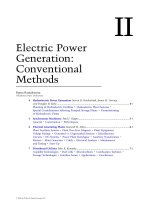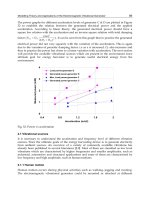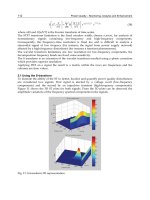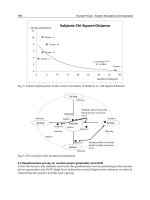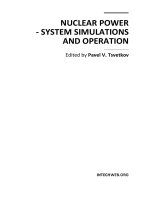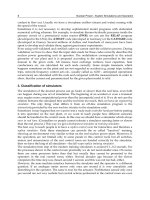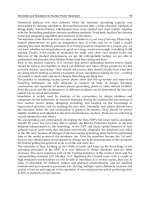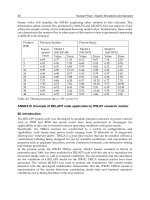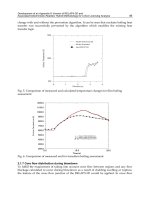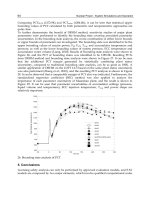Nuclear Power System Simulations and Operation Part 6 doc
Bạn đang xem bản rút gọn của tài liệu. Xem và tải ngay bản đầy đủ của tài liệu tại đây (444.91 KB, 15 trang )
Nuclear Power - System Simulations and Operation
64
Comparing PCT
95/95
(1272.9K) and PCT
order
(1284.6K), it can be seen that statistical upper
bounding values of PCT calculated by both parametric and nonparametric approaches are
quite close.
To further demonstrate the benefit of DRHM method, sensitivity studies of major plant
parameters were performed to identify the bounding state covering associated parameter
uncertainties. In the bounding state analysis, the worse combination of either lower bounds
or upper bounds of parameters are investigated. The bounding state was identified to be the
upper bounding values of reactor power, F
Q
, F
Δ
H
, T
avg
, and accumulator temperature and
pressure, as well as the lower bounding values of system pressure, ECC temperature and
accumulator water volume (Liang, 2010). Results of bounding state analysis were shown in
Figure 26, and the PCT of bounding states was identified to be 1385.2K. Resulting PCTs
from DRHM method and bounding state analysis were shown in Figure 27. It can be seen
that the additional PCT margin generated by statistically combining plant status
uncertainty, compared to traditional bounding state analysis, can be as great as 100K. A
similar application of DRHM on the LOFT L2-5 based on the same plant status uncertainty
was also performed (Zhang et al., 2010), and the resulting PCT analysis is shown in Figure
28. It can be observed that a comparable margin of PCT also was indicated. Furthermore, the
standardized regression coefficient (SRC) method was also applied to analyze the
importance of each parameter uncertainty of Maanshan plant, and the result is shown in
Figure 29. It can be seen that parameter uncertainties of accumulator settings (pressure,
liquid volume and temperature), ECC injection temperature, T
avg
and power shape are
relatively important.
-50 0 50 100 150 200 250 300
Time (s)
500
600
700
800
900
1000
1100
1200
1300
1400
1500
Peak Cladding Tempe
r
atu
r
e (k)
case1
case2
case3
case4
case5
case6 (bounding case)
case7
case9
case10
26. Bounding state analysis of PCT
5. Conclusions
Licensing safety analysis can only be performed by approved evaluation models, and E.M.
models are composed by two major elements, which involve qualified computational codes
Development of an Appendix K Version of RELAP5-3D and
Associated Deterministic-Realistic Hybrid Methodology for LOCA Licensing Analysis
65
and approved methodology. It is well recognized that B.E. analysis with full-scoped
uncertainty quantification can provide significant safety margin than traditional conservative
safety analysis, and the margin can be as great as 200K for LOCA analysis. Although a best-
estimate LOCA methodology can provide the greatest margin for the PCT evaluation during
a LOCA, it generally takes more resources to develop. Instead, implementation of
evaluation models required by Appendix K of 10 CFR 50 upon an advanced thermal-
hydraulic platform can also gain significant margin on the PCT calculation but with fewer
resources. An appendix K version of RELAP5-3D has been successfully developed and
through though assessments, the reasonable conservatism of RELAP5-3D/K calculation was
clearly demonstrated in whole area of a LOCA event, which covering hydraulics and heat
transfer in the phases of blowdown, refill and reflood.
0
0.0005
0.001
0.0015
0.002
0.0025
200 400 600 800 1000 1200 1400 1600 1800
μ=967.55 K
σ=185.6 K
PCT
APK
=1385.2 K
PCT
95/95
=1272.9 K
PCT
1st
=1256.3 K
(K)
Fig. 27. Comparison of PCTs from both DRHM and bounding appendix K analysis for
Maanshan PWR Plant
920 960 1000 1040 1080 1120 1160 1200 1240 1280
0.000
0.002
0.004
0.006
0.008
0.010
PCT
APK
=1251.5
PCT
3rd
=1162.8
PCT
95/95
=1156.9
PCT (K)
μ=1078.6
σ
2
=47.6
2
5%
Fig. 28. Comparison of PCTs from both DRHM and bounding state analysis for LOFT L2-5
Nuclear Power - System Simulations and Operation
66
Fig. 29. Importance analysis of plant status parameters
Instead of applying a full scoped BELOCA methodology to cover both model and plant
status uncertainties, a deterministic- realistic hybrid methodology (DRHM) was developed
to support LOCA licensing analysis. In the DRHM methodology, Appendix K deterministic
evaluation models are adopted to ensure model conservatism, while CSAU methodology is
applied to quantify the effect of plant status uncertainty on PCT calculation. To ensure the
model conservatism, not only physical model should satisfy requirements set forth in the
Appendix K of 10 CFR 50, sensitivity studies also need to be performed to ensure a
conservative plant modeling. To statistically quantify the effect of plant status uncertainty
on PCT, random sampling technique is applied, and both parametric and non-parametric
methods are adopted to calculate or estimate the statistical upper bounding value (95/95).
When applying the DRHM for LBLOCA analysis, the margin generated can be as great as
80-100K as compared to Appendix K bounding state LOCA analysis.
6. Reference
Analytis, G. Th, (1996). Developmental Assessment of RELAP5/MOD3.1 with Separate
Effect and Integral Test Experiments: Model Changes and Options, Nuclear
Engineering and Design, 163, 125-148.
Anklam,T. M. et al., (1982). Experimental Data Report for LOFT Large Break Loss-of-
Coolant Experiment L2-5, NUREG/CR2826.
Baker, Louis and Just, Louis, (1962). Studies of Metal-water Reactions at High Temperatures,
ANL-6548.
Bestion, D., 1990. The Physical Closure Laws in the CATHARE Code. Nuclear Engineering
and Design, 124, 229-245.
Behling, Stephen R., et al., (1981). RELAP4/MOD7-A Best Estimate Computer Program to
calculate Thermal and Hydraulic Phenomena in a Nuclear Reactor or Related
System, NUREG/CR-1998.
Development of an Appendix K Version of RELAP5-3D and
Associated Deterministic-Realistic Hybrid Methodology for LOCA Licensing Analysis
67
Boyack, B., et al., (1989). Quantifying Reactor Safety Margins: Application of Code Scaling
Applicability and Uncertainty (CSAU) Evaluation Methodology to a Large-Break
Loss-of-Coolant Accident. NUREG/CR-5249.
Cathcart, J.V., et al., (1977). Zirconium Metal-Water Oxidation Kinetics IV. Reaction Rate
Studies, ORNL/NUREG-17.
Davis, C. B., (1998). Assessment of the RELAP5 Multi-Dimensional Component ModelUsing
Data from LOFT Test L2-5, INEEL-EXT-97-01325.
David, H. A. and Nagaraja, H.N., (1980). Order Statistics. A John Wiley & Sons, INC.
Devore, Jay L., (2004). Probability and Statistics for Enginering and Sciences. The Thomsom
Corporation.
Erickson, L., et al. (1977), The Marviken Full-Scale Critical Flow Tests Interim Report:Results
from Test 22, MXC-222.
Grush, William H., et al., (1981). The Semiscale MOD-2C Small-Break (5%) Configuration
report for Experiment S-LH-1 and S-LH-2, EGG-LOF-5632.
Guba, A., et al., (2003). Statistical aspects of best estimate method-I. Reliability Engineering
and System Safety. 80, 217-232.
Henry, et al., (1971). The Two-phase Critical Flow of One-Component Mixtures in Nozzles,
Orifices, and Short Tubes, Journal of Heat Transfer, 93, 179-187.
Liang, K. S., et al., (2002). Development and Assessment of the Appendix K Version of
RELAP5-3D for LOCA Licensing. Nuelear Technology, 139, 233-252.
Liang, K. S., et al., (2002). Development of LOCA Licensing Calculation Capability with
RELAP5-3D in Accordance with Appendix K of 10 CFR 50. Nuclear Engineering
and Design, 211, 69-84.
Liang, T. K. S., et al., (2011). Development and Application of a Deterministic-Realistic
Hybrid Methodology for LOCA Licensing Analysis. Nuclear Engineering and
Design, 241, 1857-1863.
Liles, D. R., et al., (1981). TRAC-PD2: advanced best-estimate computerprogram for
pressurized water reactor loss-of-coolant accident analysis,” NUREG/CR-2054.
Loftus, M., et al., (1980). PWR FLECHT SEASET Unblocked Bundle, Forced and Gravity
Reflood Task Data Report, NUREG/CR-1531, EPRI NP-1459.
Liang, Tin-Hua, 2010. Conservative Treatment of Plant Status Measurement Uncertainty for
LBLOCA Analysis. Bachelor Thesis, Shanghai Jiao-Tong University.
Moody, F. J., (1965). Maximum floe rate of a single component, two-phase mixture, Journal
of Heat Transfer, Trans American Society of Mechanical Engineers, 87, No. 1.
RELAP5-3D Code Development Team, (1998). RELAP5-3D Code Manual, INEEL-EXT-98-
00834.
Siemens, 1988. Test No. 6 Downcomer Countercurrent Flow Test, Experimental Data Report,
U9 316/88/18.
Schultz, Richard and Davis, Cliff, (1999). Recommended Models & Correlations and Code
Assessment Matrix for Creating A 10 CFR 50.46 Licensing-Version of RELAP5-3D,
INEEL/EXT-98-01257.
Taiwan Power Company, (1982). Final Safety Analysis Report of Maanshan Nuclear Power
Station Units 1 & 2, Taipower Report.
Tapucu, A., et al., (1984). Experimental Study of the Diversion Cross-Flow Caused by
Subchannel Blockages, EPRI NP-3459.
USNRC, (1988). Appendix K to Part 50 of 10 CFR-ECCS Evaluation model.
Nuclear Power - System Simulations and Operation
68
USNRC, (1987). Compendium of ECCS Research for Realistic LOCA Analysis, NUREG-
1230.
Westinghouse Company, (2009). Best-Estimate Analysis of the Large-Break Loss-of-Coolant
Accident for Maanshan Units 1 and 2 Nuclear Power Plant Using the ASTRUM
Methodology. WCAP-17054-P.
Westinghouse, (1987). The 1981 Version of the Westinghouse ECCS Evaluation Model Using
the BASH Code, WCAP-10266-P-A Revision 2
Yoder, G. L., et al., (1982). Dispersed Flow Film Boiling in Rod Bundle Geometry-Steady
State Heat Transfer Data and Correlation Comparisons, NUREG/CR-2435, ORNL-
5822.
Zhang, Z. W., et al., 2010. Deterministic-Realistic Hybrid Methodology (DRHM) for LOCA
Licensing Analysis – Application on LOFT L2-5 LBLOCA. Journal of Nuclear
Power Engineering (China). Accepted in August 2010.
4
Analysis of Error Propagation
Between Software Processes
Sizarta Sarshar
Institute for Energy Technology
Norway
1. Introduction
All software systems can contain faults. In critical systems, this problem is alleviated by
controlling the possible effects of a fault being executed, typically through techniques for
achieving fault tolerance. Ensuring that failures are properly isolated, and not allowed to
propagate, is essential when developing critical systems.
In much of the research on error propagation analysis the focus has been on probabilistic
models. While these models are well suited for quantitative analysis, they are usually not
very specific with regard to the actual mechanisms that might allow a failure to propagate
between entities. Quantitative analysis is often applied on code level and not seen as
influenced by and in conjunction with the operating system. A more detailed insight into the
actual mechanisms can be beneficial to decide whether or not error propagation is a concern
for a given source code.
A method for studying mechanisms of error propagation between software processes was
proposed in (Sarshar, 2007). This chapter describes the method, which (1) facilitates the
study of error propagation between software processes; (2) identifies mechanisms for error
propagation; and (3) provides means to determine whether these can be automatically
detected by a static analyser. In this context a process represents a program in execution,
typically managed by an operating system. Processes can communicate with each other via
inter-process communication and their shared resources. Examples of shared resources can
be the operating system itself and the memory. The analysed problem is how one process
can cause another process to fail and concerns interaction methods available in the source
code of a program. The work criteria and scope are described in the following:
• Consider processes running on a single CPU computer with an operating system.
• The method should only require the source code and minimal manual input to work.
• The source code must compile without any errors prior to the analysis.
• The primary interest is to determine whether error propagation is a concern or not.
This chapter further reports on the applicability of the method in a case where a module of a
core surveillance framework named SCORPIO has been analysed. The framework is a
support system for nuclear power plants supporting monitoring and prediction of core
conditions.
Some of the terminologies used in this chapter are briefly described in the following (Storey,
1996):
Nuclear Power - System Simulations and Operation
70
• A fault – is a defect within the system.
• An error – is a deviation from the required operation of the system or subsystem.
• A system failure – occurs when the system fails to perform its required function.
This chapter is structured as follows: Section 2 gives a definition of error propagation,
describes the mechanisms of error propagation, and previous work on the topic. Section 3
describes the proposed method for studying error propagation between software processes.
Section 4 reports on the applicability of the method on one module of the SCORPIO
framework. Section 5 addresses the main results. Section 6 discusses the work while section
7 provides conclusions and comments on future work.
2. Background
This section gives a definition of error propagation, describes the mechanisms of error
propagation, operating systems and related work on the topic.
2.1 Error propagation
In our work, error propagation is defined as the situation where an error (or failure)
propagates from one entity to another (Sarshar et al., 2007). Errors can propagate between
different types of entities, including: physical entities, processes running on single or
multiple CPUs, data objects in a database, functions in a program, and statements in a
program. Our approach concerns propagation of errors between processes running on a
single CPU computer.
Systems of interest in our work have not been limited to those that are safety critical only,
e.g. systems that are directly involved in controlling a nuclear reactor. A problem of
particular interest is the possible negative effect a low criticality application might have on a
higher criticality application by means of error propagation because they share common
resources.
Programs make use of interaction methods provided by the underlying operating system to
communicate with each other, or make use of shared resources. These services are provided
through the system call interface of the operating system, and are usually wrapped in
functions available using standard libraries. Such interaction methods can cause errors and
provide mechanisms for error propagation. A coding fault which may be manifested as an
error may in principle be anything, e.g. an incorrect instruction or an erroneous data value.
It may be manifested inside a local function or an external function. The propagated error
need not be of the same type in different functions, e.g. an instruction error in one function
realization causes a data error in another. Even if an error is propagated to one function, this
does not necessarily mean that the source function fails functionally. The propagated error
may only be a side-effect in this function. Another type of error related to function usage is
error caused by passing illegal arguments to functions or misusing their return variables.
Error propagation between two programs may occur even if both programs individually
operate functionally correct. This can e.g. be caused by erroneous side effect in the
implementation or execution of the programs. There are two situations possible for how one
process can cause another process to fail:
• One process experiences a failure, which then causes another process to fail.
• One process propagates a fault to another process while not failing itself.
According to (Fredriksen & Winther, 2007), possible ways of characterizing error
propagation is as either intended or unintended communication or as resource conflicts.
Analysis of Error Propagation Between Software Processes
71
Error propagation in intended communication channels might consist of erroneous data
transfer through parameters or global variables. Writing to the wrong addresses in memory,
due e.g. to faulty pointers, exemplifies error propagation through unintended channels.
Processes that demand high processor load so that other processes cannot execute are
examples of resource conflicts which could cause error propagation. This indicates that error
propagation between functions can occur in at least two ways:
• An error in one function is transferred via a communication channel to another
function, for example through passing of arguments or return value.
• The execution of one function interacts with another function in an unintended and
incorrect way, due to an error, and causes the second function to fail.
Thus error propagation can take place via the intended communication channels, i.e. those
that are used by the set of functions to fulfil their tasks. It is also possible that an error in one
function generates a communication channel that is not intended and propagates the error
through this.
2.2 Operating systems
The references (Nutt, 2004; Bacon & Harris, 2003; Bic & Shaw, 2003; Tanenbaum &
Woodhull, 2006; Stallings, 2005) cover the basic principles of a number of important
operating systems.
With respect to the Linux operating system and its kernel, one source to its understanding is
given in (Bovet & Cesati, 2003). Here, the authors describe the kernel components from how
they are built to how they work. (Beck et al., 2002) explains what is in the kernel, and how to
write kernel code or a kernel module. The work in (Bic & Shaw, 2003) explains process
management and interaction in the UNIX operating system, and in (Pinkert & Wear, 1989),
the authors describe all major components of an operating system down to the pseudo code
level. The authors employ a generic approach and present the fundamental concepts
involved, alternative policies from which a designer can choose, and illustrative
mechanisms for implementing selected policies.
In (Kropp et al., 1998), the Ballista methodology is applied on several implementations of the
POSIX operating system C language API. The methodology is for automatic creation and
execution of invalid input robustness tests designed to detect crashes and hangs caused by
invalid inputs to function calls. The Ballista POSIX robustness test suite was ported to ten
operating systems where even in the best case, about half of the functions had at least one
robustness failure. The results illustrate that error propagation is a concern in operating
systems.
A study of operating system errors found by automatic and static compiler analysis applied
to the Linux and OpenBSD kernels is reported in (Chou et al., 2001). Static analysis is
applied uniformly to the entire kernel source. The scope of errors in the study is limited to
those found by their automatic tools. These bugs are mostly straightforward source-level
errors. They do not directly track problems with performance, high-level design, user space
programs, or other facets of a complete system. (Engler et al., 2000) examines features of
operating system errors found automatically by compiler extensions. Some of the results
they present include the distribution of errors in the kernel: the vast majority of bugs are in
drivers.
Our approach focuses on analysing user space programs. We examine how the operating
system manages processes and provides services to user programs through the system call
interface, but we do not analyse its code. We assume that the operating system performs its
Nuclear Power - System Simulations and Operation
72
intended functions correctly and that it is implemented correctly. Instead, we analyse the
system call interface and other process interaction mechanisms to identify whether these
may cause error propagation.
2.3 Related work
Error propagation analysis has to a large extent been focused on probabilistic approaches
(Hiller et al., 2001, Jhumka et al., 2001; Nassar et al., 2004; Abdelmoez et al., 2004) and model
based approaches (Voas, 1997; Michael & Jones, 1997; Goradia, 1993).
In (Hiller et al., 2001), the concept of error permeability is introduced as a basic measure
upon which a set of related measures is defined. These measures guide the process of
analysing the vulnerability of software to find the modules that are most likely to propagate
errors. Based on the analysis performed with error permeability and its related measures,
how to select suitable locations for error detection mechanisms (EDMs) and error recovery
mechanisms (ERMs) are described. Furthermore, a method for experimental estimation of
error permeability, based in fault injection, is described and the software of a real embedded
control system analysed to show the type of results obtainable by the analysis framework.
The results show that the developed framework is very useful for analysing error
propagation and software vulnerability, and for deciding where to place EDMs and ERMs.
The paper (Jhumka et al., 2001), assess the impact of inter-modular error propagation
between embedded software systems. They develop an analytical framework which enables
to systematically design software modules so the inter-modular error propagation is
reduced by design. The framework is developed using influence and separation metrics,
then the framework is validated using fault injection experiments, which artificially inject
faults and errors into the system. Influence metric is in their paper referred to as the
probability of a module directly influencing another module, i.e., when no other module is
considered while separation metric is referred to as the probability of a module not
influencing another one when all other modules are considered. The results showed that the
analytical framework can predict the influence value between a pair of modules very
accurately.
The study of software architectures is an important discipline in software engineering, due
to its emphasis on large scale composition of software products, and its support for
emerging software engineering paradigms such as product line engineering, component
based software engineering, and software evolution. Architectural attributes differ from
code-level software attributes in that they focus on the level of components and connectors,
and that they are meaningful for architecture. In (Abdelmoez et al., 2004), focus is on a
specific architectural attribute, which is the error propagation probability throughout the
architecture, e.g. the probability that an error arising in one component propagates to other
components. Formulas for estimating these probabilities using architectural level
information are introduced, analysed, and validated.
In (Voas, 1997), error propagation between commercial-off-the-shelf (COTS) components is
analysed using an approach termed interface propagation analysis (IPA). IPA is a fault-
injection based technique for injecting ’garbage’ into the interfaces between components and
then observing how that garbage propagates through the system. An example, if component
A produces information that is input to component B, then the information is corrupted
using fault injection techniques. This simulates the failure of component A. After this
corrupt information is passed into B, IPA analyses the behaviour of B (or components
Analysis of Error Propagation Between Software Processes
73
executed after B) to the information. IPA analyses the behaviour of a component by looking
for specific outputs that the user wants to be on the lookout for.
(Michael & Jones, 1997) presents an empirical study of an important aspect of software
defect behaviour: the propagation of data-state errors. A data-state error occurs when a fault
is executed and affects a program’s data-state, and it is said to propagate if it affects the
outcome of the execution. The results show that data-state errors appear to have a property
that is quite useful when simulating faulty code: for a given input, it appears that either all
data state errors injected at a given location tends to propagate to the output, or else none of
them do. These results are interesting, because of what they indicate about the behaviour of
data-state errors in software. They suggest that data state errors behave in an orderly way,
and that the behaviour of software may not be as unpredictable as it could theoretically be.
Additionally, if all faults behave the same for a given input and a given location, then one
can use simulation to get a good picture of how faults behave, regardless of whether the
simulated faults are representative of real faults.
Goradia (Goradia, 1993) addresses test effectiveness, i.e. the ability of a test to detect faults.
This thesis suggests an analytical approach, introducing a technique of dynamic impact
analysis using impact graphs to estimate the error propagation behaviour of various
potential sources of errors in the execution. The empirical results in the thesis provide
evidence indicating a strong correlation between impact strength and error propagation.
The time complexity of dynamic impact analysis is shown to be linear with respect to the
original execution time and experimental measurements indicate that the constant
proportionality is a small number ranging from 2.5 to 14.5. Together these results indicate
that they have been fairly successful in their goal of designing a cost effective technique to
estimate error propagation. However, they also indicate that to reach the full potential
benefits of the technique the accuracy of the estimate needs to be improved significantly. In
particular, better heuristics are needed for handling reference impact and program
components tolerant to errors in control paths.
Research on error propagation has identified frameworks and techniques for estimating
error propagation, e.g. in (Jhumka et al., 2001; Goradia, 1993). In difference, our goal is to
identify sources and mechanisms for error propagation in order to identify potential error
propagation scenarios and remove the failures to improve software.
3. Method of analysis
A method for analysing the interfaces between processes and their shared resources in the
search for mechanisms for error propagation is provided in (Sarshar, 2007; Sarshar et al.,
2007). This section describes this method which starts out by investigating how processes
are managed in the relevant operating system, enabling us to identify process characteristics
relevant to error propagation. The output of this step includes a list of system calls in the
system call interface of the operating system. Secondly, the identified interaction methods
are analysed using Failure Mode and Effect Analysis (FMEA) (Stamatis, 1995). This
approach helps to identify types of code characteristics that might be a concern in relation to
error propagation. The method of analysis can be summarized in three steps:
1. Examination of the operating system for how it interacts with and manages processes to
obtain an overview of e.g. a list of system calls and common resources;
2. Analysis of the interaction methods using Failure Mode and Effect Analysis (FMEA) to
identify possible faults that can cause error propagation to occur; and
Nuclear Power - System Simulations and Operation
74
3. Determination of how the mechanisms can be recognized in source code.
The method was developed for C code under the Linux operating system as a case. C was
chosen because it is a widely used programming language and Linux because it is an open
source operating system. In section 4, the method is applied on one module of the SCORPIO
framework.
3.1 How processes run in operating systems
Processes are managed by the operating system. An operating system provides a variety of
services that programs can utilise using special instructions called system calls. The typical
functions of an operating systems kernel are: process management, memory management,
input and output management, and support functions. In Linux, the kernel components
managing processes are the following:
• Signals: the kernel uses signals to call into a process.
• System calls (explained below).
• Process manager and scheduler: creates, manages and schedules processes.
• Virtual memory: allocates and manages virtual memory for processes.
A process interface to the operating system is either a result of the use of system calls or
through direct memory access. Use of a pointer in the C language is an example of accessing
memory without the use of the system call interface. In Linux, system calls are implemented
in the kernel. When a program makes a system call, the arguments are handled in the
kernel, which takes over the execution of the program until the call completes (Mitchell et
al., 2001). System calls are usually wrapped in the standard C library and may require some
parameters and return a value. Examples of system calls are low-level input and output
functions, such as open() and read(). The system calls of Linux can be grouped into the
following categories (Silberschatz et al., 2005; Bic & Shaw, 2003):
• Process management: create/terminate process, load, execute, end, abort, get/set
process attributes, wait for time, wait/signal event, allocate and free memory.
• File management: create/delete file, open, close, read, write, reposition, get/set file
attributes.
• Device management: request/release device, read, write, reposition, get/set attributes,
logically attach or detach device.
• Inter-process communication: the transfer of data among processes.
• Communications: create, delete connection, end, receive messages, transfer status
information, attach or detach remote device.
• Miscellaneous services: get/set time or date, system data.
The essence of our approach is to identify mechanisms for error propagation that have
characteristics detectable when analysing source code. We can therefore narrow down our
scope to include those parts of the operating system which fulfil this requirement. The
kernel components that allow interaction directly in source code of a program include the
system call interface and signals. Language specific traps and pitfalls (Hatton, 1995; Koenig,
1989) might also open ways for an error to propagate. Programming errors can give
variables incorrect values that can lead to failures. Our analysis does not specifically address
general programming errors, but errors related to invoking system calls.
We focus here on programs written to run in user space, and exclude programs written for
kernel space, as they have their own kernel API which provide services for kernel
programming.
Analysis of Error Propagation Between Software Processes
75
Figure 1 shows a simple illustration of the channels available in source code of a program
for interaction with the operating system and its resources. These include the system call
interface, signals, and traps and faults, with arrows indicating the interactions.
Hardware
Operating system
System call interface Signals
CPU
Traps & Faults
Exceptions
ReturnSystem call Signal
Source code of a program
Language faults
I/O
Interrupts
Interrupt
handler
Event
Fig. 1. Illustration of the interaction methods of the operating system on processes
An interrupt is a condition that can cause the normal execution of instructions to be altered.
Interrupts and exceptions are known as signals and are used to notify a process of certain
faults by the kernel (Pinkert & Wear, 1989):
• Completion of an input or output operation.
• Division by zero.
• Arithmetic overflow or underflow.
• Arrival of a message from another system.
• Passage of an amount of time.
• Power failure.
• Memory parity error.
• Memory protect violation.
A signal might also be altered from another program using the system call interface.
In source code, interaction with the operating system is only available through the system
call interface. It is therefore not necessary to examine how processes are handled and
managed at deeper levels.
3.2 Identify system call failures causing error propagation
In the proposed method, each system call is analysed using FMEA. The purpose is to
identify failure modes that can cause errors to propagate to other processes or the operating
system. The focus in this analysis is on failure modes that have characteristics in the source
code of a program.
FMEA is a well-known analysis method for risk and reliability analysis. The basis for this
analysis is a description of a system in terms of its components and the communication
between them. For each of the components in the system, the aim is to identify all potential
Nuclear Power - System Simulations and Operation
76
modes of failure, by investigating the following questions for each component and
communication unit, based on the FMEA framework:
• What can go wrong? (failure mode)
• How can this occur? (failure cause/mechanism)
• Which consequences will this have on the further actions and messages? (failure effects
via error propagation)
In our method, the FMEA is targeted on the system call as a component and the focus is on
its usage in source code of a program. Once the failure modes have been identified, we
determine their potential effects on local and system processes to determine whether any of
these can cause error propagation. This can be done in two ways:
• The effect is described in the system call documentation as an error the function can
return.
• The effect is determined using fault injection in test programs.
The failure effects will provide information on the severity of failures and help us provide
possible mitigation actions.
3.3 Identify the failure mode characteristics in source code
The aim of step three of the method is to determine whether the failure modes identified in
the previous step are present in the source code of a program. For each failure mode that can
cause error propagation, we determine its characteristics in code so it can be detected when
analysing an application’s source code. We then examine some existing code analysis tools
to check whether any of these will recognise the failure modes, and if they do, determine
whether they identify all of them. The next step is to develop an algorithm for identifying
the failure modes in source code, including how to traverse and check the code for the
identified failures. The result is a prototype tool which demonstrates that failures causing
error propagation can be detected by analysing source code.
The steps of the method are performed only once for an operating system and programming
language combination. The prototype tool is run for each application source code we wish
to analyse for error propagation.
4. Case on SCORPIO
SCORPIO (Surveillance of reactor CORe by Picture On-line display) is a core surveillance
framework for nuclear power plants, and is developed at the Institute for Energy
Technology (IFE). The framework is a support system for the monitoring and prediction of
pressurized water reactors (PWR), boiling water reactors (BWR) and VVER (Russian design
series of PWRs) core conditions and is running on several reactors worldwide (Barmsnes et
al., 1997). The framework has passed established system tests including factory acceptance
testing and site acceptance testing.
The general SCORPIO framework is illustrated in Figure 2. The module administrator is a
program that connects the modules to the graphical user interface made using ProcSee (IFE,
2010). ProcSee is a versatile software tool for developing and displaying dynamic graphical
user interfaces, particularly aimed at process monitoring and control. All data exchanged
between the modules and the operator is transmitted through this program. The Software
Bus handles the communication between all modules. In the case study, the input data
processing (IDATP) module of the framework has been assessed. The IDATP module
consists of 30 files and approximately 5300 lines of code.
Analysis of Error Propagation Between Software Processes
77
Module
Administrator
Graphical
User Interface
ProcSee
Module 1 :
IDATP
Software
Bus
Software
Bus
Module n
Software
Bus
Module
Fig. 2. The general SCORPIO framework
The source code of the IDATP module is first examined to identify which calls it performs to
system and library functions. The attributes passed to these external functions and the
values retrieved are stored for later analysis.
Function System call Library call Description
close x Close a file descriptor
execvp x Execute file
fclose x Close a stream file
fopen x Open a stream file; convert file to stream
fprintf x
Formatted output conversion to a given
stream
fscanf x Input format conversion
memcpy x
Copies n bytes from memory area source
to memory area destination
memset x Fill memory with a constant byte
pipe x Creates a pair of file descriptors
printf x
Formatted output conversion to
standard out stream
shmget x Allocate a new shared memory segment
signal x Signal handling
sprintf x
Formatted output conversion to a given
character string
sscanf x Input format conversion
strcat x Concatenate two strings
strcmp x Compare two strings
strlcpy x Copy string
strlen x Calculate length of string
strncmp x Compare two strings
Table 1. Analysed system and library calls
Nuclear Power - System Simulations and Operation
78
4.1 Applying the analysis
Each system and library function of the IDATP module is analysed using FMEA with focus
on identifying failure modes that can cause the module or the system itself to encounter
failure. A failure mode specifies how an entity may fail. An entity may be e.g. a variable,
used as either an argument passed to a function or used as a return variable.
The system manuals for these calls form the basis for this analysis. The IDATP module
makes use of several system and library calls. A subset of 19 of these functions, listed in
Table 1, were analysed using FMEA.
To exemplify the analysis, we focus on the shmget() system call to demonstrate the usage of
the method in the following. Thus emphasis is on the steps involved in performing the
analysis and understanding the analysis object.
The shmget() system call creates or allocates a new shared memory segment for inter-
process communication (IPC) between processes. This IPC provides a channel for
communication between processes using the memory. The main services related to shared
memory are shmget(), shmat(), shmctl(), and shmdt(). Other calls related to shared memory
include services for managing semaphores. The relation between these calls are as follows:
A process starts by issuing a shmget() system call to create a new shared memory with the
required size. After obtaining the IPC resource identifier, the process invokes the shmat()
system call, which returns the starting address of the new region within the process address
space. When the process wishes to detach the shared memory from its address space, it
invokes the shmdt() system call.
We begin with an examination of the system call documentation and then perform FMEA
on the function. When performing the analysis, the aim is to identify failure modes caused
by wrong usage of the service in source code, and determine their effects on local and
system processes. The focus is on those failure modes causing error propagation.
The synopsis for the shmget() function:
# include <sys/types.h>
int shmget(key_t key, size_t size, int shmflg);
The shmget() function returns the identifier of the shared memory segment associated with
the value of the argument key. A new shared memory segment, with size equal to the value
of size rounded up to a multiple of PAGE_SIZE, is created if:
• key has the value IPC_PRIVATE, or
• key is not IPC_PRIVATE, no shared memory segment corresponding to key exists, and
IPC_CREAT is specified in shmflg
PAGE_SIZE, IPC_PRIVATE and IPC_CREAT are definitions within the operating system.
IPC_PRIVATE is not a flag field but a key_t type. If this special value is used for key the
system call ignores everything but the least significant 9 bits of shmflg and creates a new
shared memory segment, on success. The value of
shmflg’s least significant 9 bits specify the
permission mode, the permissions granted to the owner, group, and world.
The FMEA process starts with identifying failure modes. Table 2 illustrates identified failure
modes for the shmflg parameter of shmget(). This is an excerpt from the complete FMEA
sheet for this function.
For each identified failure mode, we now examine its effects on the process itself (indicates
“local effect” in the FMEA sheet) and on other processes (indicates “system effect” in the
FMEA form). Some of these failure modes are detected by the system call; the function exits
